 |
I Could Punch a Wolf
by Jonathan Messinger,
with illustrations by Robin Muccari
Count your nightmares: terrorist bombings, cancer, invasions, bullet firings, animal attacks. All of these things dig a near-insurmountable chasm of fear in each of us because they feel so out of our control. Also, because we can't punch them in the face.
Or can we?
Say you were walking through the woods and a wolf approaches. Novels have been written about this very occurrence, and films have used this to heighten the onscreen tension. A wolf is a notoriously savage beast, one it would seem difficult to stop if one were unarmed.
The solution is fairly obvious: The human must punch the wolf in the face. And I could do it. Easily.
Now, as a vegetarian, I'm firmly against the willy-nilly punching of animals. I don't recommend this for general practice. I imagine I'd only hand-deliver my knuckle sandwich to a wolf if attacked. However, it must be noted that wolves, despite legends, rarely if ever attack humans. Wolves are scavengers and killers of small prey. Most attacks on people come after the wolf is cornered. Like any animal, a wolf will flee if frightened, and as long as that avenue is open to them, no one gets hurt. Even a starving wolf would likely look around for another piece of meat rather than mess with a human.
So, for our purposes, we'll assume that we are punching a rabid wolf. It has lost its natural instincts and is frothing about its jaws, its mind boiled in disease. It isn't long for this world. Also, given that being punched in the face is probably embarrassing for the wolf, we're going to assume that the rabies is advanced enough that it has burned through the part of the wolf's brain that feels humiliation. This is the ideal ethical situation for our battle. But just in case, let's also presume that this wolf has eaten numerous babies; perhaps a dozen. We will be, then, striking a blow against evil and preventing more baby deaths with each righteous jab.
The genesis of this essay, like many others, is rooted deep in barroom argumentation. But it also comes from a deep-seated fear of animals known for mauling: wolves, tigers, bears and, of course, lions. I haven't thought through whether any of these instructions to follow will work equally well on tigers or bears, though I suspect not. Lions are another enemy altogether. I don't even want to think about lions.
But the wolf inhabits North America and is known for being somewhat malicious, which makes it the perfect subject for this discussion. That, and it wouldn't be too hard to punch it in the face.
The Punch
It is often said that the origins of kung fu were not founded to protect against man's violence against man, but rather animal attacks, to defend in the wild. Crane style to defend and attack the way a bird might against an animal of prey, tiger style to harness the big cat's ferocious energy, etc. To my knowledge, there is no wolf style.
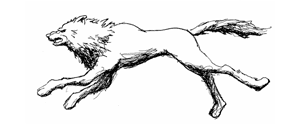 Consider the anatomy of the wolf (right). Its body is linear, without much lateral or even vertical movement. Confined to four paws on the ground, it has the ability to jump up and a bit to the side. He lacks much lateral torque, and given the fuselage shape of his body and stance, it is safe to assume that the wolf will strike in a forward thrusting motion. Likewise, the wolf only has one striking surface: Its teeth. Yes it has claws, but it's only the jaw it's truly able to lead with (unlike the lion, which has at its disposal a jaw, two full-range, swinging muscular arms, and two back legs for kicking. And, as a colleague recently reported after returning from Kenya, they have learned to climb trees. Can you imagine, just walking down the street in Kenya and a lion leaps out of a tree above you?). Consider the anatomy of the wolf (right). Its body is linear, without much lateral or even vertical movement. Confined to four paws on the ground, it has the ability to jump up and a bit to the side. He lacks much lateral torque, and given the fuselage shape of his body and stance, it is safe to assume that the wolf will strike in a forward thrusting motion. Likewise, the wolf only has one striking surface: Its teeth. Yes it has claws, but it's only the jaw it's truly able to lead with (unlike the lion, which has at its disposal a jaw, two full-range, swinging muscular arms, and two back legs for kicking. And, as a colleague recently reported after returning from Kenya, they have learned to climb trees. Can you imagine, just walking down the street in Kenya and a lion leaps out of a tree above you?).
Since we are assuming that the wolf is attacking (i.e. we are not sucker-punching the wolf) we can assume that the wolf will likely begin in a crouch, and will attack us straight on with a lunge. We'll want to dodge both to the side, and forward (right-handers stepping with their right legs, lefties the opposite). We want to stay in punching range. Stepping backwards would put us in line with the attack. Move too far to the side, and the wolf can easily recover and leap again, well on his way to eating you.
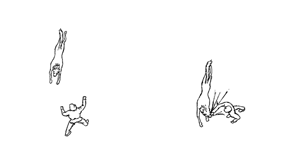 In kung fu, this is often called the Zen defense: forward and to the side (right). When the wolf springs, step forward and to the side, turning your torso square to the wolf. Yes, you'll be stepping into the wolf attack (which is awesome!), but you'll be in a better position for it. As the wolf crosses the plane, it will be able to recover somewhat and turn its face, snapping in your direction (far right). It is for this reason that a simple straight punch will not suffice. Punch from the shoulder or the hip, straight toward the wolf face, and your fist will end up in the frothy teeth of a happy wolf. In kung fu, this is often called the Zen defense: forward and to the side (right). When the wolf springs, step forward and to the side, turning your torso square to the wolf. Yes, you'll be stepping into the wolf attack (which is awesome!), but you'll be in a better position for it. As the wolf crosses the plane, it will be able to recover somewhat and turn its face, snapping in your direction (far right). It is for this reason that a simple straight punch will not suffice. Punch from the shoulder or the hip, straight toward the wolf face, and your fist will end up in the frothy teeth of a happy wolf.
So what we need to execute is what's called a "cutting punch" in kung fu. It comes out just slightly, but the follow-through cuts through the opponent's target area and circles down through and back into a defensive position (right). Our striking surface on the punch will be the knuckles of the index and the middle finger. Just two sharp knuckles, flowing through the target.
It's important to note the difference between the cutting punch and the boxer's hook punch (right). The hook punch comes out, away from the body, and hooks back in. The circular nature of the cutting punch allows the fighter to flow one technique into the next seamlessly. One of the biggest misconceptions about punching a wolf in the face--I hear it again and again—is that once the punch is done it's done. Not true! Once a wolf is punched in the face there is a very real possibility that it must be punched again in the face, and potentially again until it has learned its lesson. And the closer you are, remember, the fewer weapons the wolf has at its disposal, but the more your arsenal increases (shorter punches, backfists, chops, etc.)
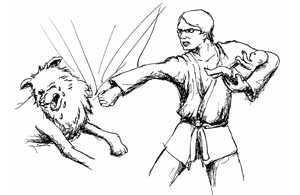 An alternative that I favor is called a teardrop punch. A teardrop is another type of cutting strike, one that is also circular and employs the first two knuckles as its striking surface. To execute a teardrop, instead of keeping the fist in standard upright position, one rotates the fist inward, so that the palm faces out and the back of the hand is turned toward the target (right, executed while holding baby). The knuckles strike through in a downward cutting motion, allowing for more power, and a closer attack. This is the punch we're going to use on our baby-eating, rabid wolf, because this is the punch we use to make wolves cry. Also, it's a much prettier punch than the average cutter, and if you're going to punch wolves in their faces, you might as well look good doing it. An alternative that I favor is called a teardrop punch. A teardrop is another type of cutting strike, one that is also circular and employs the first two knuckles as its striking surface. To execute a teardrop, instead of keeping the fist in standard upright position, one rotates the fist inward, so that the palm faces out and the back of the hand is turned toward the target (right, executed while holding baby). The knuckles strike through in a downward cutting motion, allowing for more power, and a closer attack. This is the punch we're going to use on our baby-eating, rabid wolf, because this is the punch we use to make wolves cry. Also, it's a much prettier punch than the average cutter, and if you're going to punch wolves in their faces, you might as well look good doing it.
The Pack
One final concern is that wolves rarely travel alone. Now, in our situation, it's probably safe to assume that rabid baby-eaters operate alone. But, lest anyone accuse us of stacking the deck in our favor and not truthfully laying out the best way to punch a wolf in the face, let's consider dropping a full wolf pack.
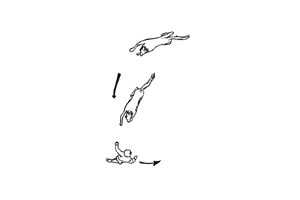 The problem, of course, is that once a wolf attacks and the pack circles, our Zen defenses will be of little use. We'll probably be stepping into the mouths of yet more wolves. When first approached by a wolf, it's important to immediately locate the second wolf and any other members of the pack. What we don't want to happen is a "circling of the wolves." The best way to prevent this is to turn the tables and begin circling the lead wolf. Or, even better, catch the lead wolf on the perimeter. Stay in front of the wolf, and move around it in the opposite direction of the wolf behind it, therefore forcing the wolves into an almost single-file arrangement (see right). Don't let the other wolf approach from the side, keep it behind the lead wolf for as long as you can. The problem, of course, is that once a wolf attacks and the pack circles, our Zen defenses will be of little use. We'll probably be stepping into the mouths of yet more wolves. When first approached by a wolf, it's important to immediately locate the second wolf and any other members of the pack. What we don't want to happen is a "circling of the wolves." The best way to prevent this is to turn the tables and begin circling the lead wolf. Or, even better, catch the lead wolf on the perimeter. Stay in front of the wolf, and move around it in the opposite direction of the wolf behind it, therefore forcing the wolves into an almost single-file arrangement (see right). Don't let the other wolf approach from the side, keep it behind the lead wolf for as long as you can.
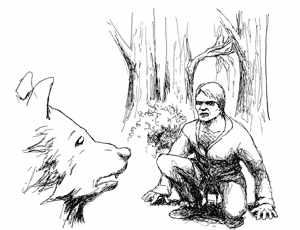 Note: Though I don't endorse this approach, if you feel that the are too many wolves and that a "circling of the wolves" is inevitable, you may consider a preemptive strike and hit the first couple of wolves immediately. I'm willing to bet that if you can line up three or four wolves, and let loose a few teardrops on their faces, the other wolves will scatter. After you've taken out four or five, you might want to look the other wolves in the eyes, howl a bit, and sniff the air as though you can smell the remaining wolves' fear (see right). Note: Though I don't endorse this approach, if you feel that the are too many wolves and that a "circling of the wolves" is inevitable, you may consider a preemptive strike and hit the first couple of wolves immediately. I'm willing to bet that if you can line up three or four wolves, and let loose a few teardrops on their faces, the other wolves will scatter. After you've taken out four or five, you might want to look the other wolves in the eyes, howl a bit, and sniff the air as though you can smell the remaining wolves' fear (see right).
Once you have defeated a wolf pack, surely you'll feel some remorse. But there's not much to be done about this. You have done your best. The wolves attacked, and you dropped punch after punch until their egos were as sore as their faces. Today you win the battle; tomorrow you'll make peace.
Jonathan Messinger is the author of the short story collection Hiding Out. He is the Books Editor of Time Out Chicago and founder and co-host of The Dollar Store Show, a literary and comedy series featuring performances inspired by junk purchased from a dollar store. In 2005 he was named one of Chicago's Top 30 Under 30 by UR Chicago, and in 2007 he was named to Newcity's top 50 literary figures in Chicago. He co-publishes Featherproof Books, and his fiction has appeared in various places, including Resonance and Rainbow Curve, and is forthcoming in Other Voices and Awake!, an anthology from Soft Skull Press.
Robin Muccari graduated from the School of the Art Institute of Chicago in 2006 with focus in illustration, printmaking, and filmmaking. Currently, he is a Design Assistant for Muse magazine and produces freelance graphic design and illustrations for the Lloyd Dobler Gallery and Ask magazine. |
|
 |
|